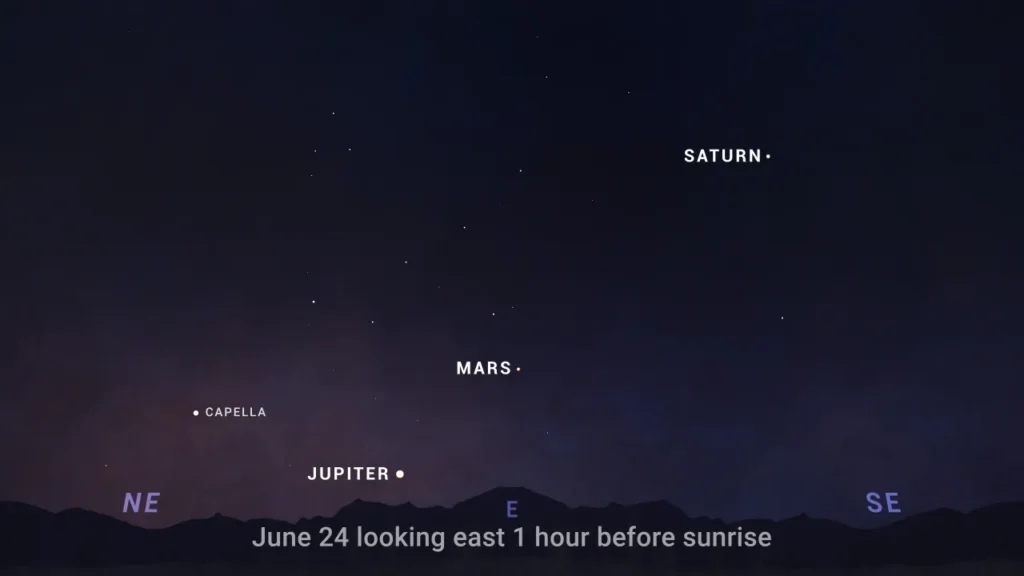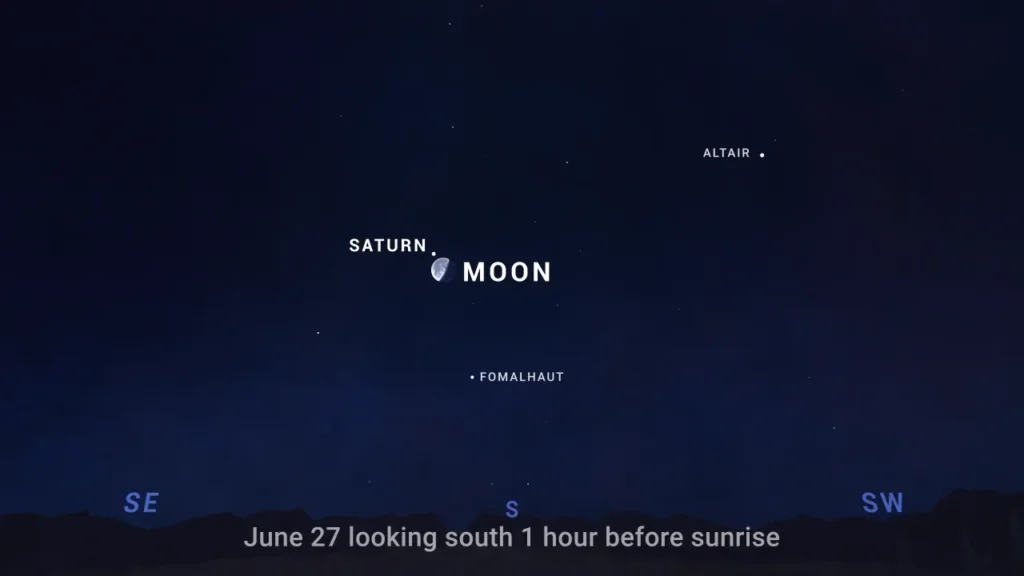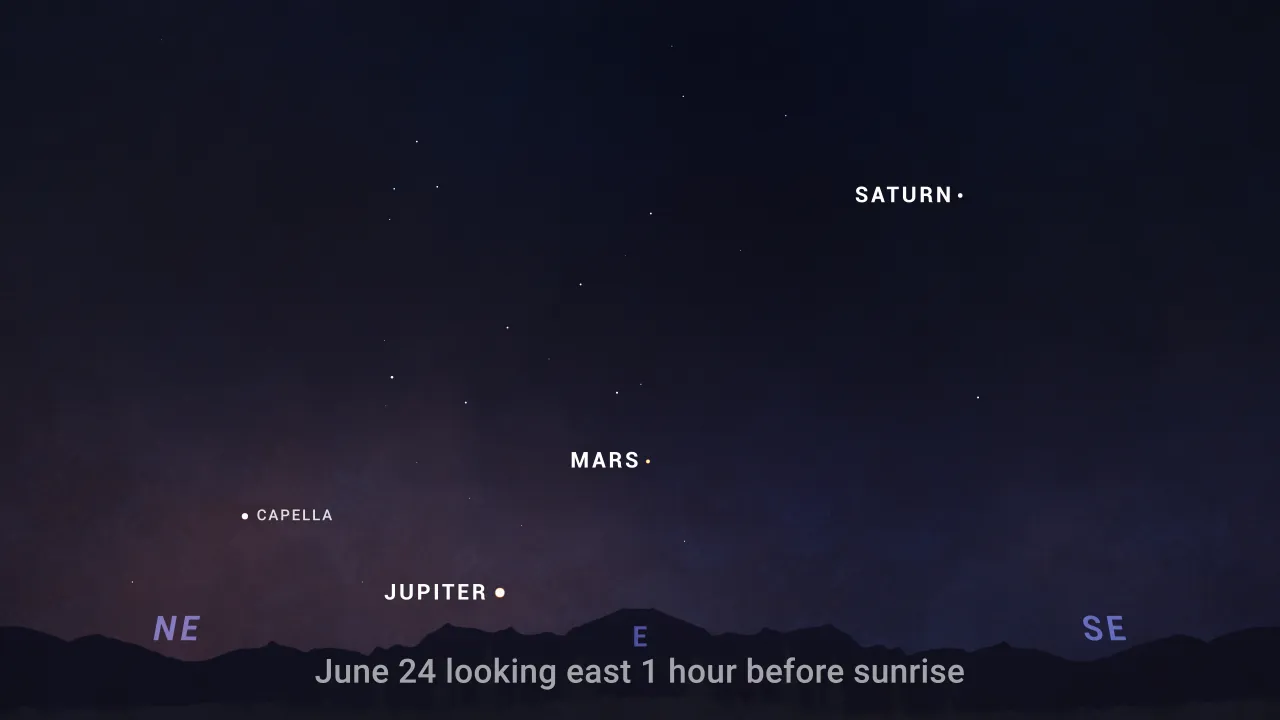June 2024 skywatching Guide, Saturn and Mars, Jupiter in June, celestial events June, morning sky planets, skywatching tips, NASA skywatching guide, planetary parade, moon phases June
Discover the exciting celestial events of June 2024 with our skywatching guide. Learn about Saturn, Mars, and Jupiter’s movements, key dates, and tips for identifying planets, stars, and other objects in the sky. Stay informed with NASA’s latest updates for a captivating stargazing experience.

June 2024 is set to be an exciting month for skywatchers, with a host of planetary events and celestial sights to observe. From Saturn and Mars rising in the early morning hours to Jupiter making a return at dawn, the night sky will be bustling with activity. Here are the highlights and tips for identifying common objects seen in the sky this month.
June 2024 Skywatching Guide Key Highlights
Planetary Action in the Morning Sky
Throughout June, the planetary action continues in the morning sky. Saturn and Mars will rise in the early morning hours, joined later in the month by Jupiter. Here are the key dates and events to look out for:
- June 2: In the hour before sunrise, reddish Mars will hang just beneath the crescent Moon. You can find the pair low in the east, with Saturn lurking nearby toward the south.
- June 3: The crescent Moon will sit beneath Mars in the morning twilight. Look for them low in the eastern sky.
- June 6: New Moon.
- June 21: Full Moon.
- June 24: Jupiter becomes visible low in the east before sunrise. Look for the bright planet around 10 degrees above the horizon during the final week of June, forming a line with Mars and Saturn that stretches toward the south.
- June 27: Look for the Moon rising in the east with Saturn around midnight. By dawn, you’ll find them high in the southern sky, appearing super close together – close enough to be in the same field of view through binoculars.
“Planet Parade” Note
Some online sources have excitedly mentioned a “parade of planets” visible in the morning sky in early June, particularly on June 3. However, in reality, only Saturn and Mars will be visible. Jupiter and Mercury will be at or below the horizon in morning twilight and not visible. Uranus and Neptune are far too faint to see without a telescope, especially as the morning sky brightens. The closest thing to a planet parade will occur on June 29, when Saturn, the Moon, Mars, and Jupiter will line up across the morning sky. This arrangement will persist into July, which will be discussed further in the next “What’s Up” video.
Observing Tips for Common Sky Objects
When you spot bright or moving objects in the night sky, it might not be immediately clear what you’re looking at. Here are a few quick tips on how to differentiate between planets, stars, satellites, and airplanes:
Planets vs. Stars
- Brightness and Steadiness: Planets tend to shine steadily, whereas stars twinkle. Stars are so far away that they’re just points of light, and ripples in our atmosphere easily distort them, causing the familiar flicker. Planets are relatively close, so their light comes from a slightly more spread-out area, making them appear more constant in brightness.
- Movement: Both planets and stars rise in the east and set in the west, moving very slowly across the sky during the night.
- Appearance through Binoculars: Through binoculars or a telescope, instead of a single point, planets show a tiny disk or crescent illuminated by the Sun.
Satellites vs. Aircraft
- Aircraft Identification: Distant aircraft follow a slow, steady path that’s straight or gently curving, with exterior lights that flash in a regular pattern, often including a red beacon.
- Satellite Identification: Satellites tend to be most visible in the hour or so after dark or before dawn. They move in slow, very steady, straight paths and might briefly flare in brightness but don’t have lights that blink. The International Space Station (ISS) is an exception, as it’s very bright and often visible for long enough to observe the curving path of its orbit, but it doesn’t have flashing lights visible from the ground.

Rocket Launches
- Rocket Launch Identification: Rocket launches that happen soon after sunset or before sunrise can be confusing. Similar to spotting satellites, this is when it’s darker on the ground, but launching rockets climb high enough to be illuminated by sunlight. Their exhaust can be brilliantly illuminated, and sometimes you might see spiral or circular shapes that slowly grow and dissipate as a spent rocket stage empties its propellant into space.
Phases of the Moon for June
- New Moon: June 6
- Full Moon: June 21

Stay up to date on NASA’s missions exploring the solar system and beyond at NASA Science.
By familiarizing yourself with these common sights in the night sky, you can enhance your skywatching experience and focus on investigating whatever mysteries and wonders you seek. Happy observing!
This article provides an overview of the exciting celestial events happening in June 2024, along with tips for identifying various objects in the night sky. Whether you’re an avid skywatcher or a casual observer, there’s plenty to look forward to this month.
Read More-
- NASA PREFIRE Mission: Tiny Satellites Measuring Earth Polar Heat Loss
- NASA Launches Tiny CubeSat to Revolutionize Earth Observation
- Boeing and NASA Proceed with Starliner Launch Despite Helium Leak
- NASA and Sierra Space Dream Chaser Arrives in Florida for Launch Prep










